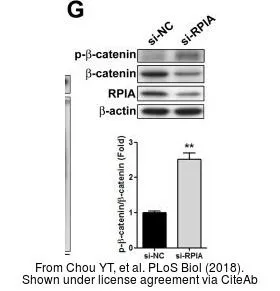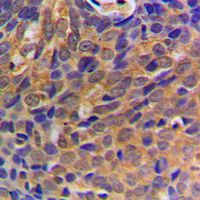
The data was published in the journal PLoS Biol in 2018.PMID: 29337987
beta Catenin (phospho Ser33/Ser37) antibody [BC-22]
GTX11350
ApplicationsWestern Blot, ELISA
Product group Antibodies
TargetCTNNB1
Overview
- SupplierGeneTex
- Product Namebeta Catenin (phospho Ser33/Ser37) antibody [BC-22]
- Delivery Days Customer9
- Application Supplier NoteWB: 5-10 microg/ml. *Optimal dilutions/concentrations should be determined by the researcher.Not tested in other applications.
- ApplicationsWestern Blot, ELISA
- CertificationResearch Use Only
- ClonalityMonoclonal
- Clone IDBC-22
- Concentration2 mg/ml
- ConjugateUnconjugated
- Gene ID1499
- Target nameCTNNB1
- Target descriptioncatenin beta 1
- Target synonymsCTNNB, EVR7, MRD19, NEDSDV, armadillo, catenin beta-1, catenin (cadherin-associated protein), beta 1, 88kDa
- HostMouse
- IsotypeIgG2b
- Protein IDP35222
- Protein NameCatenin beta-1
- Scientific DescriptionThe distinct peripheral cytosolic proteins, alpha, beta and gamma-catenin (102, 94 and 86 kD) found in many tissues bind to the conserved cytoplasmic tail domain of the cell-adhesion cadherins. Catenins link E-cadherin to other integral membrane or cytoplasmic proteins and are modulated by Wnt-1 proto-oncogene. They are good candidates for mediating transduction of cell-cell contact positional signals to the cell interior. Absence of alpha-catenin is found in certain tumor cell lines and reduced levels in certain human carcinomas. Beta-catenin binds directly to the cytoplasmic tail of E-cadherin. It binds to the N-terminus of alpha-catenin and interacts with the protein product of the tumor suppressor gene APC. This interaction involves a 15-aa repeat in the APC. Beta-catenin cell levels seem to be controlled by APC. The central core region of beta-catenin is involved in mediation of cadherin-catenin complex interaction with EGFR.
- Storage Instruction-20°C or -80°C,2°C to 8°C
- UNSPSC12352203
References
- Identification of a noncanonical function for ribose-5-phosphate isomerase A promotes colorectal cancer formation by stabilizing and activating beta-catenin via a novel C-terminal domain. Chou YT et al., 2018 Jan, PLoS BiolRead more

![FACS analysis of HeLa cells using GTX17706 beta Catenin antibody [CTNNB1/2030R]. Blue : Primary antibody Red : Isotype control](https://www.genetex.com/upload/website/prouct_img/normal/GTX17706/GTX17706_20200115_FACS_186_w_23060620_180.webp)
![ICC/IF analysis of HeLa cells using GTX17731 beta Catenin antibody [rCTNNB1/2173]. Green : Primary antibody Red : nucleus](https://www.genetex.com/upload/website/prouct_img/normal/GTX17731/GTX17731_20200115_ICC-IF_224_w_23060620_546.webp)
![IHC-P analysis of human tonsil tissue using GTX17954 beta Catenin antibody [CTNNB1/2098].](https://www.genetex.com/upload/website/prouct_img/normal/GTX17954/GTX17954_20200115_IHC-P_1276_w_23060620_742.webp)
